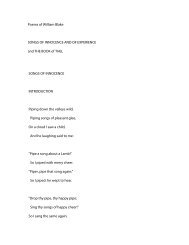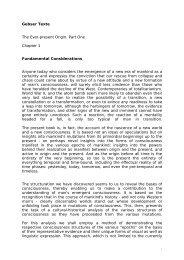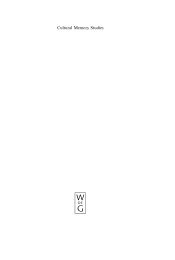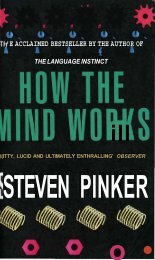The Mass Psychology of Misery - michaeljgoodnight.com
The Mass Psychology of Misery - michaeljgoodnight.com
The Mass Psychology of Misery - michaeljgoodnight.com
Create successful ePaper yourself
Turn your PDF publications into a flip-book with our unique Google optimized e-Paper software.
problem, not its solution. Thus Thomas Bittker writes <strong>of</strong> "<strong>The</strong> Industrialization <strong>of</strong>American Psychiatry" (American Journal <strong>of</strong> Psychiatry, February 1985) and GinaKolata discusses how much distrust <strong>of</strong> doctors exists, as medicine is seen as justanother business (New York Times, February 20, 1990).<strong>The</strong> mental disorder <strong>of</strong> going along with things as they are is now treated almostentirely by biochemicals, to reduce the individual's consciousness <strong>of</strong> socially inducedanguish. Tranquilizers are now the world's most widely prescribed drugs, and antidepressantsset record sales as well. Temporary relief-despite side-effects andaddictive properties-is easily obtained, while we are all ground down a little more.<strong>The</strong> burden <strong>of</strong> simply getting by is "Why All Those People Feel <strong>The</strong>y Never Have AnyTime," according to Trish Hall (New York Times, January 2, 1988), who concludedthat 'everybody just seems to feel worn out" by it all.An October '89 Gallup poll found that stress-related illness is be<strong>com</strong>ing the leadinghazard in the nation's workplaces, and a month later an almost five-fold increase inCalifornia stress-related disability claims was reported to have occurred between1982 and 1986. More recent figures estimate that almost two-thirds <strong>of</strong> new cases inemployee assistance programs represent psychiatric or stress symptoms. In hisModern Madness (1986), Douglas La Bier asked, "What is it about work today thatcan cause such harm?"Part <strong>of</strong> the answer is found in a growing literature that reveals the Information Age"<strong>of</strong>fice <strong>of</strong> tomorrow" to be no better than the sweatshop <strong>of</strong> yesteryear. In fact,<strong>com</strong>puterization introduces a neo-Taylorist monitoring <strong>of</strong> work that surpasses allearlier management control techniques. <strong>The</strong> "technological whip" now increasinglyheld over white-collar workers prompted Curt Supplee, in a January '90 WashingtonPost article, to judge, "We have seen the future, and it hurts." A few months earlierSue Miller wrote in the Baltimore Evening Sun <strong>of</strong> another part <strong>of</strong> the job burnoutpicture, referring to a national clinical psychology study that determined that no lessthan a staggering 93 percent <strong>of</strong> American women "are caught up in a bluesepidemic."Meanwhile, the suicide and homicide rates are rising in the U.S. and eighty percent<strong>of</strong> the populace admit to having at least thought <strong>of</strong> suicide. Teenage suicide has risenenormously in the past three decades, and the number <strong>of</strong> teens locked up in mentalwards has soared since 1970. So very many ways to gauge the pain: serious obesityamong children has increased more than fifty percent in the last fifteen to twentyyears; severe eating disorders (bulimia and anorexia) among college women are nowrelatively <strong>com</strong>mon; sexual dysfunction is widespread; the incidence <strong>of</strong> panic andanxiety attacks is rising to the point <strong>of</strong> possibly overtaking depression as our mostgeneral psychological malady; isolation and a sense <strong>of</strong> meaninglessness continue tomake even absurd cults and IV evangelism seem attractive to many.<strong>The</strong> litany <strong>of</strong> cultural symptomatics is virtually endless. Despite its generally escapistfunction, even much <strong>of</strong> contemporary film reflects the malaise; see Robert PhillipKolker's A Cinema <strong>of</strong> Loneliness: Penn, Kubrick, Scorsese. Spielberg, Altman, forexample. And many recent novels are even more unflinching in their depiction <strong>of</strong> thedesolation – and degradation <strong>of</strong> society, and the burnout <strong>of</strong> youth in particular, e.g.Bret Easton Ellis' Less Than Zero, Fred Pfail's Goodman 2020, and <strong>The</strong> KnockoutArtist by Harry Crews, to mention just a few.
















